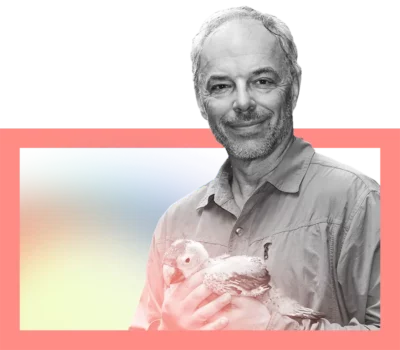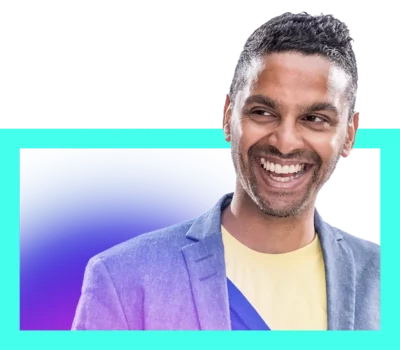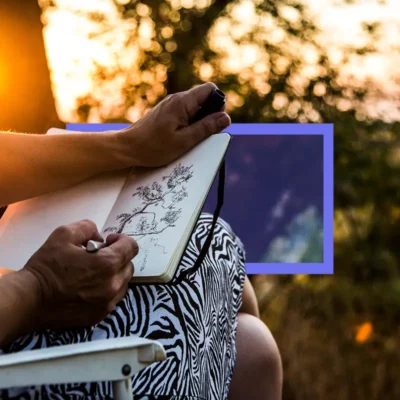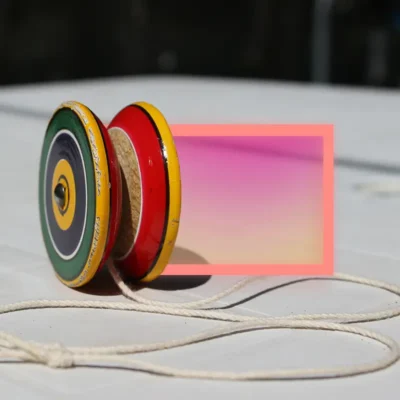Loving our living world
We all need to love and be loved, we all want to feel not alone in this world. And this is true for all of the living world, says ecologist and author Carl Safina. Carl has spent his whole life interacting with the wild, from raising pigeons on a Brooklyn rooftop to trekking through the frozen landscape of Antarctica and the vast African savanna. And one thing he’s learned is that humans and animals alike, we’re all striving to connect. We’re all craving to establish bonds, to reach out, and to hold someone close. We all want to be loved – and to love ourselves.
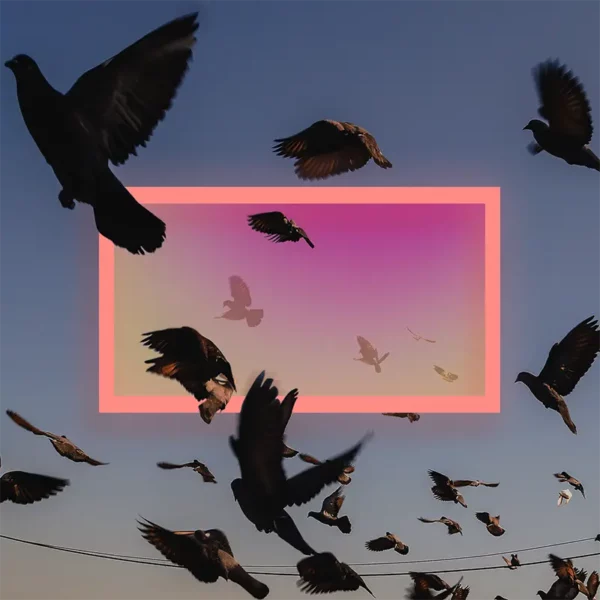
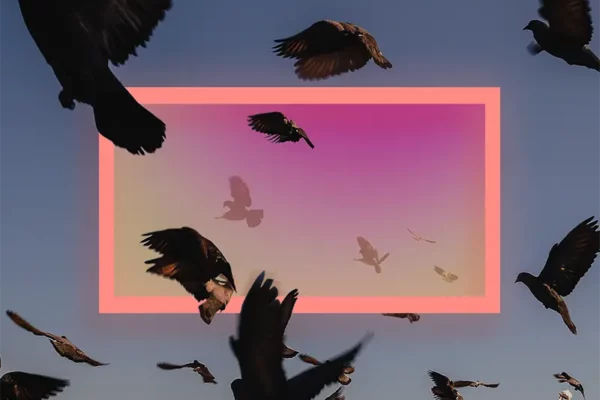
Table of Contents:
Transcript:
Loving our living world
CARL SAFINA: One weekend my parents take me to the Bronx Zoo. As we stroll through the exhibits, I find myself standing beside a large cage with an eagle almost my size perched inside. I stare, fascinated. Struck by its piercing eyes, gigantic feet and claws, and enormous brown and white feathers. My father reads the sign to me: “This is a Steller’s sea eagle.” This is not a fierce, mindless creature. We are, simply and innocently, seeing eye to eye, recognizing the “each” in each other.
ROHAN GUNATILLAKE: With an expertise in ecology, Carl Safina has written extensively about the living world over the years, and has won a whole host of awards and recognition. But more importantly, his work has brought the majesty and mystery of nature to countless people of all ages. In today’s Meditative Story, Carl draws on his decades of studying and living with animals, and touches on the question that has fascinated him from a young age: How different are they from us really?
In this series, we combine immersive, first-person stories, breathtaking music, and mindfulness prompts, so that we may see our lives reflected back to us in other people’s stories. And that can lead to improvements in our own inner lives. From WaitWhat, this is Meditative Story. I’m Rohan, and I’ll be your guide.
The body relaxed. The body breathing. Your senses open. Your mind open. Meeting the world.
SAFINA: We live in a tenement flat in Brooklyn. It’s a three story walk-up, a modest building fronted with brown tarred shingles like you only see on roofs nowadays. The building has five apartments. My family and relatives occupy three of them. We frequently call back and forth to one another; our voices ring through the hallways, doors are left open, and I’m welcome to walk in and out of any aunts’ and uncles’ apartments.
When most people think of Brooklyn, they probably don’t think of wildlife. But all you have to do is lean out of your window and look up: there are flocks of pigeons, turning in gyres over the rooftops.
My father raised pigeons as a teenager; it was a common hobby in New York. Like many boys my age, I emulate my father, and I beg him for pigeons of my own. “You’re only seven years old,” he tells me. But I’m persistent.
My father helps me fix up a dilapidated tool-shed in our backyard. Our yard is small – but not tiny. I unroll tar-paper. My father nails shingles. We replace rotted wood, make an outdoor screened enclosure with a big door, and cut a hole in the wall so the pigeons can go back and forth. We put up perches. We install a water canister and make a wooden food trough.
My father promises me that we’ll go get our first pigeons tomorrow. In my excitement, I invite two friends over to see the new coop. When we get there, to my delight, I find two handsome homing pigeons, a male and a female, already sitting in the enclosure. I burst with excitement; this surprise is my father’s doing! The young male is an all-over charcoal gray. The female has a white splash on her head and pure white wing-tips.
Two, of course, is just the beginning of the flock. In my neighborhood in Brooklyn, pet stores are as likely to sell pigeons in their front window as dogs or cats. We choose only sleek homing pigeons. He shows me how to hold them: in one hand, with their head facing me, two fingers around the wingtips, thumb up, and two fingers on either side of both feet. Pigeons are compact, sturdy. We must be firm and sure and gentle. We want only young ones who will quickly consider our coop their coop, our flock their flock.
Our flock grows. Four. Six. A dozen.
They are my responsibility. I feed them and maintain the coop. In winter I haul down steaming water, the vapors rising upwards as I pour the hot water over their canister to melt the ice into drinking water. Every morning, I open the screen coop and the pigeons stream out, their wings clapping rapidly. They fly steeply upwards and over the surrounding apartment buildings, peppering life into the Brooklyn sky.
When they have had their exercise, they flutter onto the lowest of the surrounding roofs, I shake a coffee can with their food. The sound of dried seeds and peas and corn pinging off of the tin walls of the can calls the flock back to the coop in an instant. I pour the seeds into their trough, and they eat briskly. We’re friends.
Occasionally, a bird from another flock attaches to our birds, and I can’t help but think it must be unhappy with its own flock – and perhaps just lonely enough to fly with birds who are strangers, to a strange coop.
I love spending time in the coop, smelling their feathers, watching them eat, listening to their murmurs and coos.
The coop is arranged for breeding. Against the inner walls, we stack wooden fruit crates, three high, on their side, their open top facing out. In each we put a bowl; in a corner, a pile of tobacco stems, the perfect nesting material.
Day by day, week by week, I watch as they court and choose who they’ll mate with. Sometimes they fight over mates; sometimes they jostle and compete for who will get an “apartment.” They arrange the tobacco stems into nests. I watch them produce miraculous eggs. They sit faithfully. I watch the changing of the guard: when a mate takes over and the pigeon who’d been incubating goes for a sip of water. I observe how the rhythm of their days involves parents who leave for a while, come back, have their supper and feed their babies, and go to sleep for the night.
It’s natural and obvious that right across the yard, we live in our own stack of boxes. Grown-ups have decided who they’re going to mate with. Sometimes they too fight about mates, or compete for an apartment. Parents leave for the day and return at night, have supper, feed their kids, and go to sleep.
The pigeons take care of their young ones and so do we. We both try to avoid pain and be comfortable. The similarities are obvious.
One weekend my parents take me to the Bronx Zoo. As we stroll through the exhibits, I find myself standing beside a large cage with an eagle almost my size perched inside. I stare, fascinated, struck by its piercing eyes, gigantic feet and claws, and enormous brown and white feathers. My father reads the sign to me: “This is a Steller’s sea eagle.”
I notice a small branch lying on the ground. I pick it up and poke it through the bars of the cage. The eagle bites the tip of the branch with its huge yellow bill. I tug. The eagle tugs back. I tug again. We’re playing. I know this, intuitively. This is not a fierce, mindless creature. This is a being who understands what’s happening, and is pleased to have a bit of boredom relieved. Our minds are meeting in the sharing of our little game. We are, simply and innocently, seeing eye to eye, recognizing the “each” in each other. We understand what we’re doing together.
Exactly what this eagle is thinking about, precisely how life feels to it – I don’t know. But I also don’t know that about my father. Or what my neighbors think, what their family means to them, what concerns them, what they yearn for or dream at night. To me, they too remain as mysterious as the eagle and the eagle no less mysterious as them.
GUNATILLAKE: Let’s sense into that mystery. Whatever is happening in your experience right now, notice how alive it feels. Sensations in the body, thoughts, feelings in the mind – even if they are unclear. As real as this feels, do we know for sure if anyone, if anything has the same kind of experience?
SAFINA: Years after the eagle – and years after I have to move away from my pigeons – I begin university. Sitting in my lectures, I am stunned to learn that “anthropomorphizing” – attributing human qualities to animals – isn’t just discouraged, it’s forbidden.
The thoughts and emotions of animals cannot be known, I’m told. And they must be assumed to be completely different from those of people. And yet, the great organizing principle of biology is that all life is related, literally, in a deep organic history. Evolution. We’re all family.
I study the neurotransmitting chemicals in human brains and the brains of other animals. I am not surprised that other animals act in ways that make sense to me; that they act fearful in the presence of danger, aggressive when defense is called for, or affectionate with mates. Because, well, so do I!
You can see a brain, but you can’t see a mind. Yet you can see the workings of a mind in the logical way in which animals behave. As I tell you this story, my office manager’s dog has jumped into my lap. I’ve never given a treat to this dog. I’ve never fed her or contributed to her survival in any way. This dog does not know me as the provider of anything material, and yet this whole time she’s been next to me, trying to get up on my lap to be right where she is right now. Why does she do that? She’s not here to get a treat. She’s here because she simply wants to be close.
There are various reasons for why we become attracted to someone, what causes us to fall in love, why we gravitate to certain individuals. There’s chemistry involved as well. Sometimes we just don’t understand exactly why we’re drawn to people. But we know we want to be near them.
GUNATILLAKE: How does what Carl just said make you feel? Do you recognize it? Do you agree? Or is there some struggle here? Be aware of how you are resonating to what Carl is sharing.
SAFINA: When my wife and I first meet, we are strongly drawn to one another. More than anything, I just love to be with her. I just want to be around her.
I phone her or she phones me and we meet on our bicycles and bike through the neighborhood. We go down to the docks on the bay shore nearby. We look at the gulls, we look for the fish hawks called ospreys, we look in the water for crabs on the pilings, maybe walk to a nearby pond to watch the ducks.
I’ve been to a lot of wild places in my life, far-flung exotic places from Antarctica to the African savanna – but I just love these little bike rides to the bay with her, looking for what we can see. This is our thing. Shared interests and values gives us something to talk about. But what we’re really doing is forming an emotional bond.
People say, “I don’t know what my dog is thinking.” Well I also don’t know what my wife is thinking. I don’t know if she’s thinking about what we’re going to have for dinner, or if she’s thinking about how much she loves me despite, I hope, the stupid thing I said this morning. But I know she’s thinking about something. As a human, she might choose to tell me what she thinks, how she feels, or she can choose to lie about it. Animals often show us what they’re thinking or how they’re feeling. Our dogs let us know if they want to go out or want us to take them for a car ride or just want to lie alongside next to us. It doesn’t have to be in words for us to understand the truth of it.
These things are completely intentional because the bonds are deep and strong. We have skills for maintaining bonds and seeking each other and maintaining that proximity. These behaviors have been saved in the evolution of all this diversity because they are important in the conduct of lives. We’ve differentiated to varying degrees but we’ve saved so many of these deep commonalities.
I think we all want not to feel alone in the world. We want to feel like we have some company, that we have the safety and simple comfort of another presence who cares.
GUNATILLAKE: If you are listening to this and there are people around you, notice what their presence feels like. If you’re listening to this and there is no one, then notice what that feels like. Whatever your situation, name how you feel. Connected, lonely, confident?
SAFINA: It’s the summer of 2010. It’s a horrible summer. The Deepwater Horizon’s well gushes oil into the Gulf of Mexico. I’ve been contracted to write a book about the disaster, and I travel repeatedly back and forth between my home on Long Island and the Gulf. The people I talk to there are shell-shocked. They are fishermen and residents, everyday people whose identities and incomes are fully entangled with the Gulf. The two cannot be separated. Many are convinced that they will never get this place, or their lives, back.
I feel an overwhelming survivor’s guilt. I cannot help but think, “These people’s lives are shattered, they are stranded in a catastrophe, yet I can just go home.”
In this same summer, a weak, emaciated baby raccoon falls from the tree where her den is, at the edge of our yard. Her mother has been killed by a car. We bottle-feed her and nurse her back to health. Raccoons are not particularly beloved animals. Most people see them as scavengers. But like the pigeons of my childhood, raccoons, as this little one quickly affirms, are fellow beings, in search of safety and security, sustenance and play.
It’s early August when I arrive home from one of many trips to the Gulf. My wife is already in bed and the raccoon is right there sleeping beside her. We have this rule of “no animals on the furniture or in the bed,” but tonight I just shrug it off. I am so happy to be home and out of that nightmare in the Gulf that I say to myself, “What’s the big deal? It’s fine,” as I slide into bed with the raccoon between us.
I lie there beside them, the bedroom windows open, listening to the song of the cicadas. It’s August, high summer, the most languid time of the year. Everything feels so beautiful and peaceful compared to where I’ve just come from. I don’t want to fall asleep. I want to prolong this moment. Soak it all in. My mind drifts. I think about how my work brings me face-to-face with this see-sawing duality between our broken relationship with the living world – the destruction of nature, polluted seas, the extinction crisis, the climate crisis – and the so miraculous and sacred living world that strives to survive. I am compelled to address the problems. But as I lay here tonight, I am inspired to savor the remaining beauties.
At this moment, the raccoon, who is down between us, just below our knees, creeps up alongside me, lays across my throat, and falls back to sleep. She could choose to sleep anywhere, yet she decides to be as close to me as possible, feeling comfortable and safe.
The moon is full and light floods our bedroom as I lay there quietly, fur in my face. I gently elbow my wife. She opens one eye to see the little raccoon across my neck and says softly, “That’s pure love.”
Other animals have a love that is genuine and, at this moment, that’s what she’s showing me as she stays nestled across my throat. Pure love is not her state all the time. Neither is it our state all the time. Sometimes she is playful. Sometimes she just wants to eat. Sometimes she is fearful, or figuring out a way to challenge us or thwart our will. But right now, as the cicadas sing outside and moonlight streams through the window, she is showing a real, true, and genuine thing. Pure love.
Love may not be all we need. But this much is true: By every indication, love is something shared not just by humans, but by many kinds of animals throughout the world. We, all of us, need to love and be loved; to hold someone close.
“Yes,” I think to myself. “That’s exactly what this is, pure love.”
Rohan closing meditation
GUNATILLAKE: Thank you, Carl.
Out of all the rich wisdom that Carl’s story offers us, there are three themes I want to explore together for our remaining few minutes.
The first is the idea of the animal body. The racoon nestled against Carl’s neck, the dog on his lap. This animal body we all share. Sense into it now. Be aware of your body as a whole. Whether it’s moving or relatively still. A body breathing. This process shared by all mammals. This breath, shared by all mammals. Shared by pretty much all life. Breathe. Breathe with everything.
Now moving to feelings, thoughts, moods, emotions. The stuff of our minds which can be reduced to a dance of neurotransmitters, that same dance seen in the brains of animals. Watch your thoughts as they come and go. And if there is space here in the mind, watch that too. So, the experience you’re having right now is often understood as neural activity, firing and connecting. Does it feel like that in any way? Notice really closely. Listen really closely.
And the third and final theme I want to draw from Carl’s story is that of the importance of bonds. The need to love and be loved. To hold something close. If it feels safe and you’re ok doing so, putting one in the other, hold your own hand. Hold it close. Notice how it feels. One part of your animal body joining another, creating feelings, igniting neurotransmitters. A physical bond between you and you. Relax your awareness into that bond, that connection, and enjoy it if you can.
And let your hand in your hand be an expression of love. One hand wanting to be close to another, and the other here to receive it. A circuit complete. A circuit which exists in all beings. Beings near, far. Small and large. The universal wish for being close to another. The universal wish to be the one another is close to. This need for love we animals all share. And a need all us animals can provide. Thank you.
